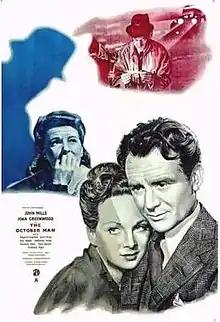The October Man
The October Man is a 1947 mystery film/film noir starring John Mills and Joan Greenwood, written by novelist Eric Ambler, who also produced. A man is suspected of murder, and due to the lingering effects of a brain injury sustained in an earlier accident, and after intensive police investigation, he begins to doubt whether he is innocent.
| The October Man | |
|---|---|
 theatrical poster | |
| Directed by | Roy Ward Baker |
| Produced by | Eric Ambler |
| Written by | Eric Ambler |
| Starring | John Mills Joan Greenwood Kay Walsh |
| Music by | William Alwyn |
| Cinematography | Erwin Hillier |
| Edited by | Alan Jaggs |
Production company | |
| Distributed by | General Film Distributors (UK) Eagle-Lion Films (US) |
Release date | 28 August 1947 (London) 15 April 1948 (NYC) 20 May 1948 (US gen'l) |
Running time | 91 minutes |
| Country | United Kingdom |
| Language | English |
| Budget | over $1 million[1] |
Plot
When a bus crashes due to faulty steering, passenger Jim Ackland (John Mills) sustains a serious brain injury and a young girl under his care is killed. Guilt-ridden, he attempts suicide twice during his recovery.
He starts a new job as an industrial chemist and gets a room in a hotel. When he reluctantly accepts an invitation for a night out, he meets Jenny Carden (Joan Greenwood), the sister of his colleague, Harry (Patrick Holt). They begin seeing each other quite regularly. Things reach the point where he confesses he wants to marry her, but he tells her he wants to be sure he has fully recovered first.
Molly Newman (Kay Walsh), one of the other hotel residents, asks to borrow £30 from him, a rather substantial sum. As he doesn't have that much on him, Jim agrees to write her a cheque. She is found strangled the next night. Wilcox (Jack Melford), a married businessman Molly had been seeing, has an alibi. Jim admits to have been walking in the vicinity of the murder site; that plus the recovered cheque from the crime scene and his head injury make him the prime suspect. Police Inspector Godby (Frederick Piper) suspects he was another of Molly's boyfriends and that, after falling in love with Jenny, he wanted to rid himself of a possible blackmailer.
When Jim learns that Mr Peachy, the person who lived in the room directly below Molly's, had falsely told the police that Jim was in her room every night, Jim confronts him in his room. Peachy brazenly admits killing Molly, confident that there is no evidence against him. He had regularly given her money; when Jim made her a loan, it had given rise to Peachy’s insane jealousy, with fatal results.
Jim goes to the police, but they don’t believe him. When they come to take him into custody, Jim flees. He follows Peachy to Paddington Station, then discovers from a tag on the man’s luggage that he intends to flee the country by plane. He phones Godby with the flight information, but, when that appears to have no effect, contemplates suicide again. Then a letter Molly had posted to Wilcox just before her death is found. It incriminates Peachy, who is arrested. Jenny finds Jim and gives him the good news.
Cast
- John Mills as Jim Ackland
- Joan Greenwood as Jenny Carden
- Edward Chapman as Mr. Peachy
- Kay Walsh as Molly Newman
- Joyce Carey as Mrs. Vinton, a hotel resident
- Catherine Lacey as Miss Selby, the hotel manager
- Patrick Holt as Harry Carden
- Felix Aylmer as Dr. Martin
- Frederick Piper as Detective Inspector Godby
- John Boxer as Detective Sergeant Troth
- George Benson as Mr. Pope, a sympathetic hotel resident
- Jack Melford as Wilcox
- Adrianne Allen as Joyce Carden
- Esme Beringer as Miss Heap
- Ann Wilton as Miss Parsons
- James Hayter as Garage man
- Sid James as uncredited man who bumps into Ackland when he first arrives at Brockhurst Common
Cast notes:
- John Mills' daughter, Juliet Mills, plays the part of the young child who is killed in a bus accident at the beginning of the film. She was five years old at the time, and it was her third film appearance.[2]
Production
Director Roy Ward Baker was an assistant director for Alfred Hitchcock on The Lady Vanishes (1938), while cinematographer Erwin Hillier had performed the same function for Michael Powell and Emeric Pressburger on I Know Where I'm Going (1945).[3] The film was made at Denham Studios in Buckinghamshire, England, and location shooting was done at Paddington Station in London.[4] The film's sets were designed by the art director Alex Vetchinsky.
Reception
In his New York Times review, Bosley Crowther called it a "second rate film" with "a first-rate actor [John Mills]...surrounded by a generally competent cast".[5] In general, though, the film received good critical notices.[3]
According to trade papers, the film was a "notable box office attraction" at British cinemas in 1947.[6][7]
Notes
- https://archive.org/stream/variety167-1947-09#page/n65/mode/1up
- Juliet Mills at IMDb
- Rob Nixon "The October Man" (TCM article)
- IMDB Filming locations
- Bosley Crowther (18 April 1948). "The October Man,' British Film Starring John Mills, Has Its Premiere at Bijou". New York Times. Retrieved 23 October 2008.
- Robert Murphy, Realism and Tinsel: Cinema and Society in Britain 1939-48 2003 p209
- Thumim, Janet. "The popular cash and culture in the postwar British cinema industry". Screen. Vol. 32 no. 3. p. 258.